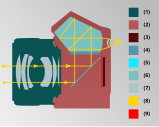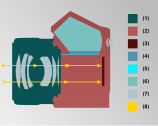Reflex camera
An reflex camera is a photographic camera in which the user (the photographer) directly sees the image to be photographed through an optical viewfinder without any kind of parallax error.
Light enters the camera through the lens, is reflected in a mirror (hence the name, coming from the English reflex which means reflection), and through it the image reaches the viewfinder. There are two types of SLR cameras: SLR (single-lens reflex) and TLR (twin-lens reflex).
Operation
To understand how SLR cameras work, first of all we must know the elements that compose it, which are the following:
- Target lenses
- Folding mirror placed at 45o if we are looking through the camera viewer and climbing when we shoot
- Obturator
- Sensor or movie
- Focus screen
- Image-size reducer lens to adapt to the viewer
- Pentaprisma
- Visor
Knowing this, we can now understand how these types of cameras work. The most important element is the folding mirror, since it is the one that regulates the path that the light follows inside the camera. The light constantly enters through the objective, but while we are not taking the picture, this mirror is kept lowered with an inclination of about 45º. Thanks to this inclination, the light is diverted to the pentaprism, which in turn reflects the light until it reaches the viewfinder, where the photographer stands to visualize the composition of the image. In the lower part of the viewfinder we will also see some of the camera parameters, such as the shutter speed, the aperture of the diaphragm or the focus point.
Until now we were talking about the mechanism of the camera when a picture is not being taken. Now, this behavior changes slightly when it is fired. The light, as before, enters through the objective, but it takes a different path than before. This time, as we have pressed the shutter release button on the camera, the folding mirror has risen, so the light continues its straight path, until it hits the sensor or film, where the image will be captured. Since the mirror is no longer positioned to reflect light back into the pentaprism, the photographer will no longer see the image through the viewfinder.
Single-lens reflex (SLR) camera
35mm camera
It has a movable mirror behind the objective, with a 45° inclination, which directs the light upwards, to a five-sided prism (pentaprism or pentamirror) that in turn projects the image in the viewfinder so that it can be observed by the photographer. All this eliminates framing errors (parallax error). These cameras have a large assortment of accessories. The focal plane shutter is on the camera body, positioned just in front of the film or digital sensor, allowing lens to be changed without danger of blurring the film or shocking the sensor. Single-lens reflexes are easy to focus manually, and the latest generations before digital ones already incorporated most of the metering and autofocus systems, but they are heavier and more complex than non-reflexes.
Medium Format
The mechanism is essentially the same as the 35mm, but larger (lenses, mirror, viewfinder, shutter). They have the viewfinder up, so you have to put them at waist level, but many accept a pentaprism (as a removable accessory, unlike most 35mm SLRs), so you look at it in the same position as the other ones. 35mm. The film or the sensor, being larger, gives a better quality than 35 mm. Most models have interchangeable film cassettes, allowing you to change reels without finishing. Some have the shutter built into the lens and sync with the flash at any speed (Hasselblad). Film sizes: (6 x 4.5), (6 X 6), (6 X 7), (6 X 8) and (6 X 9). All these sizes come from the same type of 120 or 220 film, with the only difference between them being the number of photos that can be exposed. (4.5 X 6) in 120 are 15 photos; in 220, 30 photos, etc.
Advantages
- The main advantage of the réflex cameras is that what we see is what will come out in the photo, with a precision in the frame next to 100% (to 100% only the viewers of the professional-size/advanced-speaker réflex cameras arrive).
- A wide variety of objectives and accessories (there are certainly non-reflex cameras like the Leica and Contax that have interchangeable objectives and accessories, but these equipment, apart from being very expensive, are more limited in terms of variety).
- It mechanically locates very high shutting speeds, exceeding 1/500 s with ease. This is due to the focal plane shutter located in front of the capture device (film or sensor), which is typical of all 35 mm and most medium-format shutters.
- Most of the 35 mm and some medium-format have photometry systems and exposure controls more sophisticated and precise than non-reflex.
Disadvantages
- Higher weight and volume than a non-reflex camera (enclosing in no réflex a cameras with direct viewer, compact or telemetric, such as the Leica M series. In digital format there are also these types of cameras such as Leica's digital M series, usually hand-made cameras and high-costs so they move away from the standard consumer.
- Movement of the curtains in the focal plane shutter, together with the frame of the mirror during the capture, which produces more vibrations and noise in the réflex than in the non-reflex with central shutter.
- Impossibility to look during image capture. This is possible to be corrected by a viewer located on the flash shoe, which would have the same parallax error as a compact or telemetric camera; however, because they are accessories not provided by the makers of the réflex cameras, some users prefer the telemetric cameras to the latter.
Contenido relacionado
Credit card
EMac
Bicycle


